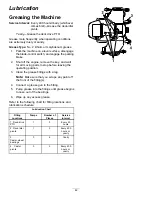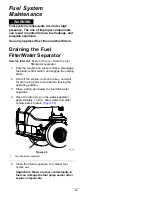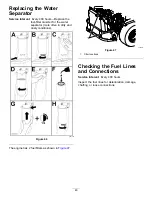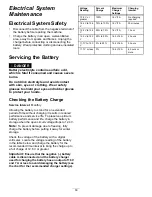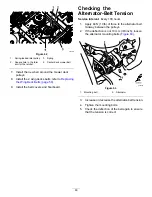
Electrical System
Maintenance
Electrical System Safety
•
Disconnect the cable from the negative terminal of
the battery before repairing the machine.
•
Charge the battery in an open, well-ventilated
area, away from sparks and flames. Unplug the
charger before connecting or disconnecting the
battery. Wear protective clothing and use insulated
tools.
Servicing the Battery
DANGER
Battery electrolyte contains sulfuric acid,
which is fatal if consumed and causes severe
burns.
Do not drink electrolyte and avoid contact
with skin, eyes or clothing. Wear safety
glasses to shield your eyes and rubber gloves
to protect your hands.
Checking the Battery Charge
Service Interval:
Monthly
Allowing the battery to stand for an extended
period of time without charging it results in reduced
performance and service life. To preserve optimum
battery performance and life, charge the battery in
storage when the open circuit voltage drops to 12.4 V.
Note:
To prevent damage due to freezing, fully
charge the battery before putting it away for winter
storage.
Check the voltage of the battery with a digital
voltmeter. Locate the voltage reading of the battery
in the table below and charge the battery for the
recommended time interval to bring the charge up to
a full charge of 12.6 V or greater.
Important:
Ensure that the negative (–) battery
cable is disconnected and the battery charger
used for charging the battery has an output of 16 V
and 7 A or less to avoid damaging the battery (see
the chart for the recommended charger settings).
Voltage
Reading
Percent
Charge
Maximum
Charger
Settings
Charging
Interval
12.6 V or
greater
100%
16 V/7 A
No charging
required
12.4 V to 12.6
V
75% to 100%
16 V/7 A
30 minutes
12.2 V to 12.4
V
50% to 75%
16 V/7 A
1 hour
12.0 V to 12.2
V
25% to 50%
14.4 V/4 A
2 hours
11.7 V to 12.0
V
0% to 25%
14.4 V/4 A
3 hours
11.7 V or less
0%
14.4 V/2 A
6 hours or
more
50







